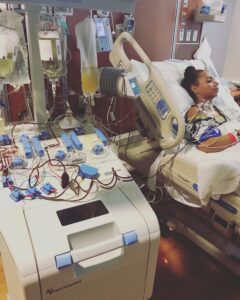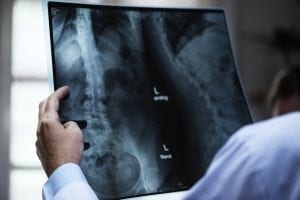In life, we are faced with a variety of obstacles. But it is the choices we make in facing these obstacles which define ourselves and our legacies. For Avery Allmond, she once set out to be a track and field star. In 2017, she was 19 years old, a college student on a full-ride scholarship, and working to better establish herself in the athletic sphere. Just before her sophomore year of college, Avery made the decision to develop her track career – and that is when she came face-to-face with an unexpected obstacle: her neuromyelitis optica spectrum disorder (NMOSD) diagnosis.
But while NMOSD ultimately caused Avery to leave track, it propelled her into an entirely new space: advocacy and activism. Recently, I sat down with Avery to discuss how she has turned her diagnosis into a positive ordeal; how and why she founded the Couch Pennies Foundation; and advice for those who are newly diagnosed.
Neuromyelitis Optica Spectrum Disorder (NMOSD)
Neuromyelitis optica spectrum disorder (NMOSD) is a rare inflammatory disorder which impacts the brain and spinal cord. Many consider NMOSD to be an autoimmune condition. In this case, the immune system mistakenly attacks the myelin sheath, or protective nerve covering, which causes optic nerve and spinal cord inflammation.
NMOSD causes unpredictable relapses, or attacks, that cause worsening symptoms and neurological disability. These attacks can reoccur after days, months, or even years. NMOSD is most commonly diagnosed in women in their 30s-40s, but can affect people of any age, race, or gender.
Because of the symptoms, NMOSD is sometimes misdiagnosed as multiple sclerosis (MS). Major symptoms of NMOSD include, but are not limited to:
- Optic neuritis and myelitis (inflammation of the optic nerve and spinal cord)
- Eye pain (which may be severe)
- Vision loss in one or both eyes
- Changes in bladder control
- Joint and muscle stiffness
- Headaches
- Nausea and vomiting
- Spine, limb, and back pain
- Arm and leg paralysis
- Confusion
- Seizures
Because neurological damage from NMOSD attacks can be irreversible, it’s essential that people living with the condition receive an accurate diagnosis and appropriate treatment as early as possible . Currently, there are some FDA-approved therapies for patients with NMOSD: Enspryng, Soliris, and Uplinza. Some doctors may also recommend corticosteroids (especially during an attack) or immunosuppressant treatments.
Avery’s Story
In 2017, Avery Allmond would have described herself as:
“An athlete, a college student, a very carefree person, kind of just taking life as it is.”
She began running in high school and immediately connected to the sport; it made her feel powerful and free. Ultimately, this led to Avery continuing her journey in college and making track a bigger part of her future.

As she began to transition from freshman year to sophomore year, she solidified her goal of taking her track career to the next level. Every day, she worked out at least twice. She changed her diet. These changes made a difference; Avery felt herself growing stronger and more powerful by the minute. For all intents and purposes, Avery was at her physical peak.
NMOSD Symptoms
But that summer, things began to shift during a trip to California. As Avery described it:
“I was very fatigued, more so than normal, but chalked it up to traveling. Then I started feeling immense pain in my arms and legs to the point where I kept telling everyone I was with. My left eye started to have such intense pain that it turned into a migraine and even though I had had migraines before, the pain was nothing like this.”
At first, Avery wasn’t sure if this was something she should worry about. Her friends wondered if it was just traveling fatigue, but her mom promised that Avery could visit a doctor when she got home. Ultimately, this was a good idea, as her symptoms kept worsening. For example, on her flight home, Avery explained:
“I noticed that while I was reading my book, the words were very blurry. I panicked because I had never once had a migraine that took my vision from me. By the time I got home, the pain was only getting worse in my legs and my eyes.”
The Journey to Diagnosis
When Avery finally did return home, her mother took her to the emergency room. After describing her symptoms, the doctors were convinced that it was just a bad migraine. Some of the treatment did work; Avery explained that she went home with about 50% of her pain having been reduced. But the pain never fully went away. In fact, over the next day or two, the arm and leg pain intensified, as did her blurry vision. Avery returned to the emergency room but was once again treated for a migraine and sent home.
On her third visit to the emergency room in less than a week, Avery was growing increasingly worried. She told the doctors:
“This is really bad. I can’t see and I don’t know what to do.”
This time (perhaps surprisingly) Avery did not receive a migraine diagnosis. Unfortunately, she also did not receive her NMOSD diagnosis. Instead, the doctors told Avery that she had anxiety and set her up with a neurologist who later prescribed depression and anxiety medication. Could that be what her symptoms boiled down to? Avery didn’t necessarily believe she was depressed, but if that’s what the doctors were saying…
Discovering NMOSD
But everything changed one morning when she woke up being unable to really move. As she described it:
“I woke up not being able to move my extremities the way that I wanted to. I tried to get up and stumbled to the bathroom, but I couldn’t do anything and my pain was so intense. I screamed for my mom and she tried to get me dressed, but I was in so much pain that she could hardly touch me.”
For the fourth time in just about one week, Avery went back to the emergency room. This time, it was clear that she was not suffering from a migraine, nor from anxiety. Shortly after she was admitted to the hospital, she lost vision in her right eye. Paralysis set in throughout her body.

This began her diagnostic odyssey: vision and eye tests and scans. But ultimately, Avery feels grateful for how quickly she was able to receive her diagnosis. She explained:
“I know people whose NMOSD diagnoses took ten years to determine. Mine was under two months, and I had the specialist right here in my own city.”
Learning about NMOSD
When she was first diagnosed, Avery explained that her first thought was:
“What’s going to happen to my track career and when can I run again? It was kind of hard; I couldn’t really accept the fact that track wasn’t going to be a part of my life anymore and I had to focus on rehabilitation.”
Understandably, Avery went through a mourning period, a period of adjustment in which she had to relearn herself. She explained that her body, personality, and everything she knew about herself had changed.
But after about one year, she knew that she wanted to use her experience for something positive. She thought:
“This sucks but I don’t want it to be bad for other people. I don’t want other people to miss out and I want everyone to have an equal chance to thrive. How can I be an advocate and what can I do to help?”
In part, Avery began using her Instagram account to raise awareness around NMOSD and other rare diseases. But she always knew that she wanted to take her advocacy one step further.
Thus, the Couch Pennies Foundation was born.
The Couch Pennies Foundation
On the website, Avery describes the Couch Pennies Foundation as:
“An unincorporated non-profit association that strives to educate and advocate ALL rare diseases, provide resources to patients and their loved ones, and fundraise for rare disease causes.”
When Avery was around 12 years old, she was inspired by someone she knew with neuroblastoma, a rare cancer that forms from immature cells in nerve tissues. As Avery watched this girl go through her diagnosis and treatment journey, something stuck out: the financial difficulties associated with treating rare conditions. It was at this point, Avery thought:
“Okay, I want to cure cancer. I want to help people. But I sat on that idea for a while until it emerged again after my diagnosis.”
Throughout 2017 and 2018, Avery spent a good portion of her time planning how to develop the Couch Pennies Foundation, what direction to take it in, and where the biggest need for help, support, or resources exist. Ultimately, she was able to launch the Foundation officially in 2018.
Unique Events
Since then, the Couch Pennies Foundation has been working to make a change. While Avery stated that the organization is building slowly but surely, the Foundation has made strides in the rare disease space through donations, care packages, grants, and research. In one experience, Avery explained:
“I was invited to the Capitol and I was able to share my story, what Couch Pennies is, and what the organization aims to do. I was fortunate enough to have some legislators there watching and listening, which ultimately helped to bring about other opportunities.”
Through the Foundation, Avery also hosted a Spartan Race in San Francisco for two years in a row. During this, she partnered with a fitness studio in the Castro district. After pledging money, participants competed in obstacle courses. This event also offered the opportunity to share her story with participants, alongside information around NMOSD.
Paint Your Hands Project
Through the Couch Pennies Foundation, Avery also managed the Paint Your Hands project for Rare Disease Day. This was based on an idea from the official Rare Disease Day, which has historically done different activities with paint to raise awareness about the over 7,000 rare diseases which exist. For her project, Avery stated that:
“I wanted to take this a step further. I wondered how I could highlight the different rare diseases in all the shapes and forms, and asked some of the most inspirational people that I found on social media to participate. Most were able to paint their hands and we had people from all different parts of the world participate.”
The project not only served to highlight the journey of those with rare diseases, but to help create a community and raise awareness. Avery viewed this as one of her most inspirational and influential projects thus far.

For Rare Disease Day 2021, Avery also spoke at an event in association with the National Organization of Rare Diseases (NORD), Rare Disease Day Official, and Rare Action Colorado.
NMOSD & Rare Disease Advocacy
Outside of her work with the Couch Pennies Foundation, Avery consistently works to raise awareness around NMOSD and other rare diseases. She has worked with, and spoken with, multiple advocacy groups and pharmaceutical companies, like Genentech. She also explained:
“I had the amazing opportunity to partner with NORD as a personal advocate and am able to frequently speak with legislators about legislation, policy, and issues in this sphere.”
But one of her favorite forms of advocacy is speaking directly with those within the rare disease community. She explained that social media allows her to connect with others with rare diseases and has:
“Brought me people I now consider family. I really cherish each friendship. But what pushes me to continue to grow as an advocate are the random messages I get. I can go on Instagram every day and find a message from someone who is going through something similar and decided that I was the one they were inspired by. This reminds me that I’m doing everything for a reason, and each message is powerful and special to me.”
Avery’s Advice
In some cases, Avery just listens to those who reach out to her. In others, she offers advice and help on how to get through a new diagnosis, or what to do next:
“Knowledge is power. It is so important to have knowledge on what is going on with you, your body, your disease. There are so many resources you can access, and Foundation websites have resources that you can share with yourself, your family, or your medical team.”
Specifically, in relation to NMOSD, Avery also shared that the information available is not always accurate. For example, many people who reach out to her do not understand the residual damage and pain that can still be present following an NMOSD attack. One way to handle this, she said, is to have clear information given to all people who are newly diagnosed:
“It shouldn’t have to be hard to learn about what’s going on inside of your body. We should be able to have resources that are well put together and easily understood so that people understand that even after an attack, the disease has still made an impact inside of your body. The more knowledge you have, the more well-equipped you are to handle it.”
Becoming Avery
Now, at 23 years old, Avery is still making strides – but this time in advocacy and self-development, rather than track. She explained that her journey genuinely taught her who she is, and that:
“The Avery now is so appreciative for every second that comes with every day because, at any second, my sight and mobility could be easily taken away from me. I’m grateful, I’m compassionate, I’m empathetic towards others. I’m still on my journey but I am so excited to unveil this person I didn’t know I was and be an advocate, strong role model, and leader.”

When she isn’t raising awareness, Avery is realizing some new talents. She loves crafting, drawing, and reading books on a wide variety of topics. She spends a lot of time with her mom-
“My best friend and my caregiver, so I got a good package deal on that one.”
on crazy adventures in the car. She enjoys learning about spirituality and crystals. One of her favorite experiences is being outside; Avery describes herself as a total nature person.
Altogether, she acknowledged that reaching this point was, at times, difficult and stressful. That her life at 23 was not what she had ever imagined at 19. But in recalling her own experiences, and how far she has come, she also left off on one important idea:
“Don’t look at being diagnosed as a negative thing. The opportunity to use this rare and unique quality to change the world can be so positive.”








